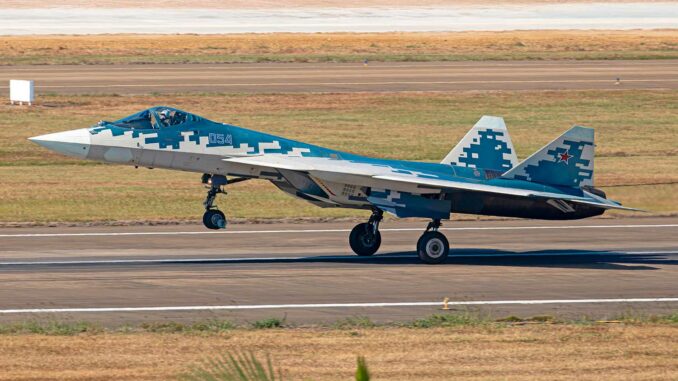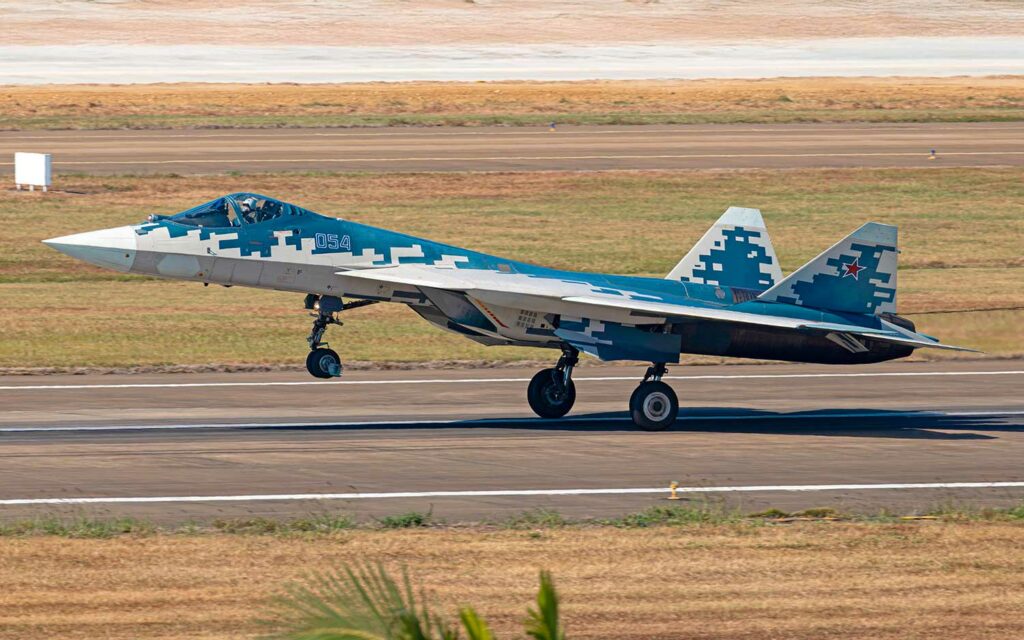
Russia claims that the Su-57 has been equipped with hypersonic weapons. Technical analysis, range, operational capability, and strategic implications.
Russia has officially confirmed that its Su-57 Felon stealth fighter has been equipped with hypersonic missiles integrated into its air arsenal. The announcement, made by Lieutenant General Alexander Maksimtsev, confirms a significant development in Russia’s strike capability. It is a clear step towards combining stealth and extreme speed, which could transform the dynamics of tactical and strategic air engagements.
The announced weapon system
The official message and its implications
The official announcement and its implications
General Alexander Maksimtsev, Chief of Staff of the Russian Aerospace Forces, has stated that the Su-57 is now equipped with modern air attack systems and hypersonic weapons. The official announcement does not specify the name or technical characteristics of the missile in question. However, several industrial sources indicate that it is a compact hypersonic air-to-ground missile, designed specifically to be carried in the fuselage in order to preserve the Su-57’s stealth capabilities. This constraint implies reduced dimensions, structural weight reduction, and integration compatible with the fighter’s avionics interfaces.
Reports dating back to February 2023 already mentioned an experimental missile under development by the Russian military-industrial complex. This missile, intended for internal carriage, is said to have similar characteristics to the Kh-47M2 Kinzhal – a ballistic missile launched from a MiG-31K – but in a shorter and less massive version. The Kinzhal is capable of reaching Mach 10 and an estimated range of 2,000 kilometers, suggesting that the new munition could maintain a similar speed with a likely more limited range. This development represents a strategic milestone in the quest for stealth strike capability at very high speeds.
Possible technical options
Three credible hypotheses are currently being discussed regarding the Su-57‘s hypersonic weaponry, each meeting the requirements for compatibility with the aircraft’s internal bays and the constraints associated with reduced radar signature.
The first option is a completely new hypersonic air-to-ground missile, designed to be smaller so it can fit inside the Su-57. This missile could use the same ballistic logic as the Kh-47M2 Kinzhal, but be shorter and lighter. It would combine speeds in excess of Mach 5 and a range of several hundred kilometers, while maintaining a profile suitable for high-altitude flight and defensive maneuvers.
The second option is based on an adaptation of the R-37M (industrial designation: izdeliye 810), a long-range air-to-air missile. Already operational on the Su-35S, this missile reaches Mach 5 to Mach 6 and has a range of close to 300 km. A modified version, with a reduced cross-section, could equip the Su-57 in a stealth configuration.
Finally, the Kh-69, a precision-guided subsonic cruise missile currently used on the Su-57, could serve as the basis for a supersonic or even hypersonic version, while retaining its compact dimensions and internal carry mode.

The Su-57 in the Russian strategic context
Technological capabilities and operational logic
The Su-57 was designed to meet the requirements of a fifth-generation fighter capable of operating in highly contested environments. Developed by Sukhoi and produced by United Aircraft Corporation, it incorporates a combination of advanced features, including a stealth airframe, concealed air intakes, radar-absorbing coating, and an architecture designed to reduce infrared signature.
Electronically, it is equipped with the N036 Byelka active electronically scanned radar, distributed across several antennas covering the front and sides, coupled with an IRST (infrared search and tracking) sensor for passive detection. These systems are supported by a comprehensive suite of electronic countermeasures designed to disrupt enemy radars and defeat guided missiles.
Internal carrying capacity is central to its doctrine of use: it can accommodate missiles, including hypersonic ones, while maintaining a low radar detection rate. Two large missiles can be placed in the longitudinal bays, and up to four more in a secondary configuration. With vectors reaching Mach 5 to Mach 10, the enemy’s reaction time is reduced to a few tens of seconds, making interception extremely difficult. This combination gives the Su-57 a tactical advantage in deep precision strike missions.
Operational limitations
Despite announcements about the Su-57‘s hypersonic weapons, several technical and industrial constraints are hampering its operational effectiveness in the short term. The first critical issue concerns production volume. To date, only a few units have been delivered to the Russian aerospace forces, far short of initial projections. In 2024, fewer than 20 units were confirmed to be airworthy, which severely limits the platform’s strategic impact on a broader theater of operations.
The second major limitation is the physical and functional integration of hypersonic missiles. These weapons are characterized by significant mass, high thermal loads during flight, and significant mechanical stresses during launch. The Su-57, designed with fixed-size internal bays, requires structural adjustments to accommodate these vectors without compromising its stealth or maneuverability. This involves costly, complex, and time-consuming modifications to each airframe.
Finally, the technological maturity of the Su-57 remains a subject of debate. The Izdeliye 30 engine, designed to provide optimal thrust vectoring, has not yet reached its final certification phase. Similarly, the radar and optronic sensors, although advanced on paper, still suffer from insufficient operational feedback, particularly in terms of maintenance and reliability in real-world deployment. These factors are slowing down the program’s ramp-up.
Military and geopolitical challenges
Adaptation to global air defense
A Su-57 armed with an internal hypersonic missile represents a major challenge. Its speed of Mach 9 to Mach 10 reduces the detection and reaction window for defenses. The Zircon missile, used by the Russian navy, reaches Mach 9 and a range of 1,000 km; the integration of similar missiles on the Su-57 would further enhance its strategic range.
Impact on global air balance
The combination of stealth and extreme speed gives Russia a rare capability: to attack without being detected for long periods of time and strike with precision from a distance. This could prompt Western allies to accelerate their own hypersonic defense and 6th generation interception programs.
Facilitating the deployment of systems such as Patriot, SAMP/T, or European equivalents will strengthen defenses against highly mobile threats. The development of high-altitude stationary radars and radio detection drones can increase reaction times.
Russia’s announcement that the Su-57 has been equipped with hypersonic weapons marks a tangible step forward in high-speed air strike capability. Combining stealth, Mach 5-10 speed, and long range, this system redefines certain standards of air power projection. However, technical challenges and limited production are currently limiting its overall impact.
For defense experts, it is essential to analyze the emergence of this capability as a sign of acceleration in the hypersonic arms race. The advanced integration of the Su-57 as a hypersonic missile platform could make the Western air theater more vulnerable if countermeasures are not developed.
War Wings Daily is an independant magazine.